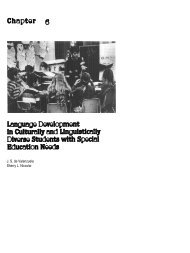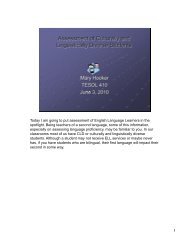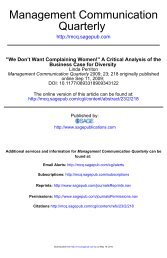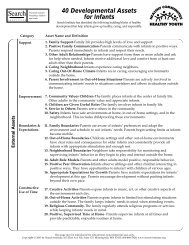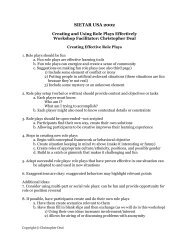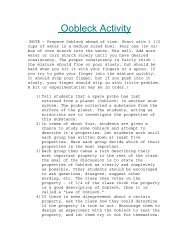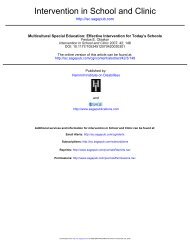Activity - Crosscultural Developmental Education Services
Activity - Crosscultural Developmental Education Services
Activity - Crosscultural Developmental Education Services
Create successful ePaper yourself
Turn your PDF publications into a flip-book with our unique Google optimized e-Paper software.
Acculturation & Culture<br />
Shock <strong>Activity</strong> set<br />
Using the AQS<br />
[Type the abstract of the document here. The abstract is<br />
typically a short summary of the contents of the document.<br />
Type the abstract of the document here. The abstract is<br />
typically a short summary of the contents of the document.]<br />
Dr. Catherine Collier<br />
1/3/2013<br />
2012 Dr. Catherine Collier<br />
All Rights Reserved
The Administration Manual of the AQS contains detailed item analysis and protocol<br />
guidelines as well as information about norming, reliability, and validity.<br />
Culture Shock Exercise<br />
Remember a time when you experienced a new culture, either in the US or abroad, and<br />
the challenges or difficulties you encountered.<br />
2012 Dr. Catherine Collier<br />
All Rights Reserved<br />
1
The Administration Manual of the AQS contains detailed item analysis and protocol<br />
guidelines as well as information about norming, reliability, and validity.<br />
Acculturation Grid Exercise<br />
Think of a CLD student that you and your colleagues all know and are worried about.<br />
Profile this student on the Acculturation Grid by writing down examples of his/her<br />
behavior and performance in each of the four quadrants of the grid.<br />
Assimilation<br />
Home/heritage language & culture<br />
replaced by school/new language &<br />
culture<br />
Integration<br />
Home/heritage culture & language<br />
blended with school/new culture &<br />
language<br />
Deculturation<br />
Neither home/heritage culture &<br />
language nor school/new culture &<br />
language<br />
Rejection<br />
Intentionally rejecting home/heritage<br />
for school/new culture & language OR<br />
Intentionally rejecting school/new<br />
culture & language for home/heritage<br />
2012 Dr. Catherine Collier<br />
All Rights Reserved<br />
2
The Administration Manual of the AQS contains detailed item analysis and protocol<br />
guidelines as well as information about norming, reliability, and validity.<br />
José Case Study<br />
José immigrated to the United States with his family from Peru when he was eight years old. His<br />
father and uncle are employed in seasonal farm labor in their new community. His aunt and<br />
mother work in a meat packing plant. José’s grandmother helps take care of him and his seven<br />
siblings and cousins. She is considered a healer in their native community. She speaks only<br />
Quechua, an indigenous language from the Andes Mountains, which is the family’s native<br />
language. José, his cousins and his older siblings attended school in Peru and speak Spanish<br />
fairly well. Both of his parents speak Spanish, though with limited fluency. The family is<br />
involved in the local Catholic Church that has a large immigrant and migrant membership.<br />
There are some Mexican food stores and restaurants in the community.<br />
Culturally, he is from a traditional indigenous group who resides on both the western and eastern<br />
sides of the Andes in South America. His family is intact and extended, giving him substantial<br />
support for cognitive and linguistic development. Linguistically, his Quechua is<br />
developmentally appropriate but, as he never received schooling in his home language, he has<br />
very limited cognitive academic schema in Quechua. After two years of school in Peru, first and<br />
second grades, he has an appropriate developmental level of Spanish, i.e. at the Speech Emergent<br />
beginning bilingual level. Environmentally, he has access to safety, food, clothing, and shelter<br />
and he has supportive, responsive relationships at home. His family worked hard in Peru to<br />
make sure José was able to attend the nearest village school. <strong>Education</strong>ally, he has two years of<br />
elementary schooling albeit in Spanish, a language other than his home language or English.<br />
There are over twenty Spanish-speaking students at Jose’s new school, as well as a few<br />
Ukrainian, Hmong, Yup’ik, and Russian speakers. There is a certificated ESL teacher available<br />
within the district and school staff has some experience working with culturally and<br />
linguistically diverse students and families.<br />
When José first enrolled in his new school district, his family was identified as limited English<br />
proficient and his father was given a Home Language Survey to complete and return to the<br />
school. The results of the Home Language Survey, José’s evaluation at enrollment, and<br />
observations of José during his first weeks at the school were as follows: 1) José’s country of<br />
origin is Peru 2) The language José learned when first beginning to talk was Quechua 3) The<br />
language José most frequently uses at home is Quechua, but also some Spanish 4) The language<br />
his parents most frequently speak to José is Quechua 5) The language the primary caregiver<br />
(Grandmother) speaks to José is Quechua 6) The language most frequently spoken at home is<br />
Quechua 7) José had academic instruction in a language other than English. He had two years of<br />
academic instruction in Spanish.<br />
2012 Dr. Catherine Collier<br />
All Rights Reserved<br />
3
The Administration Manual of the AQS contains detailed item analysis and protocol<br />
guidelines as well as information about norming, reliability, and validity.<br />
Home Language Survey<br />
Date This year School Your School Grade Your grade<br />
Student’s Name<br />
José<br />
Parent or Guardian’s Name<br />
José Sr.<br />
1) What is the student’s country of origin Peru<br />
2) What language did your child learn when first beginning to talk Quechua<br />
3) What language does your child most frequently use at home Quechua/Spanish<br />
4) What language do you most frequently speak to your child Quechua<br />
5) What language does the primary caregiver speak to your child Quechua<br />
6) What is the language most frequently spoken at home Quechua<br />
7) Has the student had academic instruction in a language other<br />
than English Yes No How long Two years Language Spanish<br />
8) Please describe the language understood by your child. (Check only one.)<br />
a) Understands only the home language and no English.<br />
b) Understand mostly the home language and some English. (and Spanish)<br />
c) Understands the home language and English equally.<br />
d) Understands mostly English and some of the home language.<br />
e) Understands only English.<br />
9) If available, in what language would you prefer to receive Quechua<br />
communication from the school<br />
Translator says that Spanish is okay if home visitor can come in<br />
person.<br />
2012 Dr. Catherine Collier<br />
All Rights Reserved<br />
4
The Administration Manual of the AQS contains detailed item analysis and protocol<br />
guidelines as well as information about norming, reliability, and validity.<br />
1 st Acculturation Quick Screen<br />
NAME/ID#: José XX SCHOOL: Elementary DOB: 5/16/xx SEX: M GRADE:<br />
2nd AGE AT ARRIVAL IN U.S.: 8 LANGUAGE(S) SPOKEN AT HOME: Spanish<br />
and Quechua AQS at enrollment: Date of first AQS: Date of current AQS: 10/1/xx<br />
CULTURAL/ENVIRONMENTAL FACTORS Information Scores<br />
1. Amount of time in school in United States/Canada 36 days .2<br />
2. Amount of time in Your School/District 45 hours .04<br />
3. Time in ESL or Bilingual ELL <strong>Education</strong> About 10 hours .03<br />
4. Home, Native Language Proficiency Quechua BICS 3<br />
5. School English Language Proficiency Does not speak English 1<br />
6. Bilingual Proficiency Quechua 1<br />
7. Ethnicity/Cultural Identity Quechua 1<br />
8. % in School Speaking Student’s<br />
1% Quechua 6<br />
Language/dialect<br />
AQS Score Total: 12.27<br />
1. Time in school in US/Canada:<br />
Less than 180 days (1 yr/good atten) instruction = 1<br />
Between 190 – 360 days (2yrs/good atten) of instruction = 2<br />
Between 370 – 540 days (3yrs/good atten) of instruction = 3<br />
2. TIME in your School/District:<br />
Less than 1080 hours (1 yr/good atten) instruction = 1<br />
Between 1090 - 2160 hours of instruction = 2<br />
Between 2170 - 3240 hours of instruction = 3<br />
3. TIME in ELL or Bilingual program<br />
Less than 360 hours of direct instruction = 1<br />
Between 360 and 500 hours of direct inst. = 2<br />
Between 500 and 800 hours of direct inst. = 3<br />
4. HOME, Native Language Proficiency<br />
Does not speak language, pre-production = 1<br />
Early production to low speech emergence = 2<br />
High speech emergence to intermediate fluency = 3<br />
5. SCHOOL ENGLISH Language Proficiency<br />
Does not speak language, pre-production = 1<br />
Early production to low speech emergence = 2<br />
High speech emergence to intermediate fluency = 3<br />
6. BILINGUAL Proficiency<br />
Essentially monolingual = 1<br />
Primarily one, some social in other = 2<br />
Limited academic either language, social both =3<br />
7. ETHNICITY/Cultural Identity<br />
American Indian, Native American, Alaska. Native,<br />
Indigenous Populations or First People = 1<br />
Hispanic/Latino/Chicano, South or<br />
Central America or Caribbean = 2<br />
8. PERCENT IN your SCHOOL Speaking Student’s Language Or Dialect<br />
81% - 100% of enrollment = 1<br />
66% - 80% of enrollment = 2<br />
50% - 65% of enrollment = 3<br />
Between 1400 days to 1700 days = 4<br />
Between 1700 days to 2200 days = 5<br />
Over 2200 days = 6<br />
Between 3250 - 4320 hours (4 yrs/good atten) of instruction = 4<br />
Between 4330 - 5400 hours of instruction = 5<br />
More than 5500 hours of instruction = 6<br />
Between 800 and 1080 hours of direct instruction = 4<br />
Between 1090 and 1440 hours of direct instruction = 5<br />
More than 1450 hours of direct instruction = 6<br />
High intermediate fluency with some academic fluency = 4<br />
Advanced intermediate social & academic fluency = 5<br />
Advanced social & academic fluency = 6<br />
High intermediate fluency with some academic fluency = 4<br />
Advanced intermediate social & academic fluency = 5<br />
Advanced social & academic fluency = 6<br />
Basic academic one, intermediate academic other = 4<br />
Most academic in one, intermediate academic in other = 5<br />
Bilingual in social and academic language = 6<br />
African American, ,African, East Asian or Pacific Islander = 3<br />
West Asian or Middle Eastern = 4<br />
Eastern European = 5<br />
Western European = 6<br />
30% -49% of enrollment = 4<br />
15% - 29% of enrollment = 5<br />
0% - 14% of enrollment = 6<br />
2012 Dr. Catherine Collier<br />
All Rights Reserved<br />
5
The Administration Manual of the AQS contains detailed item analysis and protocol<br />
guidelines as well as information about norming, reliability, and validity.<br />
José after a year<br />
After a year in the school and daily two hour ESL, José’s classroom teacher, bilingual aide, and<br />
ELL teacher were all becoming concerned about his learning and behavior. In the classroom, he<br />
seemed distracted and not very attentive. He did not always respond when spoken to, although<br />
the teacher was sure he was capable of doing so. He now seemed to struggle with new content<br />
and was not making any progress with reading and writing in English. Up until now, José had<br />
always made an effort to be involved in whatever was going on in the classroom and on the<br />
playground. However, his behavior had started to deteriorate and he had started getting into<br />
trouble and not paying attention. He had thrown a few ‘temper tantrums’ when asked to complete<br />
tasks. His parents reported that he was refusing to speak Quechua at home and that he had<br />
expressed frustration when the family used their limited Spanish.<br />
José appeared to have difficulty with task analysis and identifying the separate elements of<br />
assignments in detail. He was very resistant to change and did not respond well to storytelling<br />
time. He was very quick to respond to questions, but the answers seemed impulsive and random.<br />
He gave up readily, was easily distracted and quite unstructured. When faced with new<br />
materials, José appeared particularly distressed and did not respond well to pressure. José<br />
seemed to leap to conclusions and make very broad generalizations. José responded best to<br />
physical demonstrations and concrete models.<br />
Although José came to school every day and was not generally late getting back to classes after<br />
recess and lunch, his behavior in class had started to deteriorate, and he had begun acting out,<br />
fidgeting and not paying attention. The playground monitor was afraid he had started hanging<br />
out with a group of gang ‘wannabes’ during lunchtime and no longer playing team sports with<br />
his classroom peers. His parents reported that José was sometimes acting up at home and not<br />
listening to his grandmother. José refused to speak Quechua with his grandmother and was<br />
starting to use “bad” words when he was frustrated.<br />
The instructional intervention team completed a needs prioritization checklist to assist in<br />
simultaneously addressing José’s emerging learning and behavior needs while continuing to<br />
progress in his L3 language acquisition, facilitate and accelerate his acculturation, and support<br />
his retention of L2 as a communication transfer bridge. A second Acculturation Quick Screen was<br />
administered and this time José received an AQS of 18.74. This means that after a year in the<br />
school José is still “less acculturated” though close to “in transition”.<br />
A cognitive learning style inventory was completed and it was found that José had a pattern of<br />
cognitive learning that was significantly different from and in dissonance with the teacher’s<br />
instructional style. He was easily frustrated and showed low perseverance in completing tasks.<br />
He used several learning strategies that were not appropriate in the classroom. He also displayed<br />
difficulty with task analysis and understanding and applying cause and effect. These difficulties<br />
were particularly apparent during language arts and reading comprehension activities.<br />
José’s oral proficiency scores were 2 in English and 4 in Spanish after nearly two years of pullout<br />
bilingual / ESL classes consisting of at least one hour per day every day of the week. His<br />
2012 Dr. Catherine Collier<br />
All Rights Reserved<br />
6
The Administration Manual of the AQS contains detailed item analysis and protocol<br />
guidelines as well as information about norming, reliability, and validity.<br />
classroom teacher had administered classroom language inventories, and said that his basic<br />
‘survival’ English was okay, but that he was not doing well with cognitive academic interactions.<br />
The ESL teacher, who was bilingual, said this was also true of his language interactions in<br />
Spanish. José’s scores on a comprehensive cognitive academic language test in English were a 2<br />
and a 3 in Spanish, confirming that José’s English was now at the high end of the speech<br />
emergent level and his Spanish was at the intermediate level.<br />
It was determined that the top need to address at this time was his deteriorating approach to<br />
content learning, followed by his adaptive behavior. Keeping up his English and supporting his<br />
Spanish were identified as important but not as critical as the impact of his general cognitive<br />
learning. However, when completing the needs identification checklist, it was discovered that<br />
José showed considerable difficulty with employing consistent and specific cognitive learning<br />
strategies. This led the team to monitor his use of learning strategies during the sheltered<br />
instruction and role play activities. If José did not display consistent and effective learning<br />
strategies and show improvement in his retention and application of content, the team would<br />
make provisions to address this in more intensive settings.<br />
2012 Dr. Catherine Collier<br />
All Rights Reserved<br />
7
The Administration Manual of the AQS contains detailed item analysis and protocol<br />
guidelines as well as information about norming, reliability, and validity.<br />
2 nd Acculturation Quick Screen<br />
NAME/ID#: José XX SCHOOL: Elementary DOB: 5/16/xx SEX: M GRADE: 3rd<br />
AGE AT ARRIVAL IN U.S.: 8 LANGUAGE(S) SPOKEN AT HOME: Spanish and Quechua<br />
AQS at enrollment: 12.27 Date of first AQS: 10/1/xx Date of current AQS:<br />
CULTURAL/ENVIRONMENTAL FACTORS Information Scores<br />
1. Amount of time in United States/Canada 200 days 1.15<br />
2. Amount of time in School/District 1300 hours on instruction 1.03<br />
3. Time in ESL or Bilingual ELL <strong>Education</strong> 2hrsx5dx38weeks =380 1.06<br />
4. Home, Native Language Proficiency Quechua BICS 3<br />
5. School English Language Proficiency SOLOM 13, CLIC 15 2.5<br />
6. Bilingual Proficiency Quechua, Spanish, some English 3<br />
7. Ethnicity/Cultural Identity Quechua 1<br />
8. % in School Speaking Student’s<br />
1% Quechua 6<br />
Language/dialect<br />
AQS Score Total: 18.74<br />
1. Time in school in US/Canada:<br />
Less than 180 days (1 yr/good atten) instruction = 1<br />
Between 190 – 360 days (2yrs/good atten) of instruction = 2<br />
Between 370 – 540 days (3yrs/good atten) of instruction = 3<br />
2. TIME in your School/District:<br />
Less than 1080 hours (1 yr/good atten) instruction = 1<br />
Between 1090 - 2160 hours of instruction = 2<br />
Between 2170 - 3240 hours of instruction = 3<br />
3.TIME in ELL or Bilingual program<br />
Less than 360 hours of direct instruction = 1<br />
Between 360 and 500 hours of direct inst. = 2<br />
Between 500 and 800 hours of direct inst. = 3<br />
4. HOME, Native Language Proficiency<br />
Does not speak language, pre-production = 1<br />
Early production to low speech emergence = 2<br />
High speech emergence to intermediate fluency = 3<br />
5. SCHOOL ENGLISH Language Proficiency<br />
Does not speak language, pre-production = 1<br />
Early production to low speech emergence = 2<br />
High speech emergence to intermediate fluency = 3<br />
6.BILINGUAL Proficiency<br />
Essentially monolingual = 1<br />
Primarily one, some social in other = 2<br />
Limited academic either language, social both =3<br />
7.ETHNICITY/cultural identity<br />
American Indian, Native American, Alaska. Native,<br />
Indigenous Populations or First People = 1<br />
Hispanic/Latino/Chicano, South or<br />
Central America or Caribbean = 2<br />
8. PERCENT IN your SCHOOL Speaking Student’s Language Or Dialect<br />
81% - 100% of enrollment = 1<br />
66% - 80% of enrollment = 2<br />
50% - 65% of enrollment = 3<br />
Between 550 – 720 days (4 yrs/good atten) of instruction = 4<br />
Between 730 – 900 days (5 yrs/good atten) of instruction = 5<br />
More than 920 days of instruction = 6<br />
Between 3250 - 4320 hours (4 yrs/good atten) of instruction = 4<br />
Between 4330 - 5400 hours of instruction = 5<br />
More than 5500 hours of instruction = 6<br />
Between 800 and 1080 hours of direct instruction = 4<br />
Between 1090 and 1440 hours of direct instruction = 5<br />
More than 1450 hours of direct instruction = 6<br />
High intermediate fluency with some academic fluency = 4<br />
Advanced intermediate social & academic fluency = 5<br />
Advanced social & academic fluency = 6<br />
High intermediate fluency with some academic fluency = 4<br />
Advanced intermediate social & academic fluency = 5<br />
Advanced social & academic fluency = 6<br />
Basic academic one, intermediate academic other = 4<br />
Most academic in one, intermediate academic in other = 5<br />
Bilingual in social and academic language = 6<br />
African American, ,African, East Asian or Pacific Islander = 3<br />
West Asian or Middle Eastern = 4<br />
Eastern European = 5<br />
Western European = 6<br />
30% -49% of enrollment = 4<br />
15% - 29% of enrollment = 5<br />
0% - 14% of enrollment = 6<br />
2012 Dr. Catherine Collier<br />
All Rights Reserved<br />
8
The Administration Manual of the AQS contains detailed item analysis and protocol guidelines as well as information about<br />
norming, reliability, and validity.<br />
Language Acquisition Grid<br />
Pre-Production Early Production Speech Emergent Intermediate Fluency Advanced Intermediate Advanced Fluency<br />
0-6 months 6 months-1 year 1-2 years 2-3 years 3-5 years 5-7 years<br />
-Associates sound to<br />
meaning<br />
Develops listening<br />
strategies<br />
Depends on context<br />
-Has minimal receptive<br />
vocabulary<br />
-Comprehends key words<br />
only<br />
-Points, draws, or gesture<br />
responses<br />
-May not produce speech<br />
-Adjusting to U.S. culture<br />
-0-500 receptive word<br />
vocabulary<br />
-Able to observe, locate,<br />
label, match, show, classify,<br />
sort<br />
-Beginning L2 (second<br />
language) sound symbol<br />
understanding if literate in<br />
L1(first language)<br />
-Speech is so halting and<br />
fragmentary as to make<br />
conversation virtually<br />
impossible<br />
-Depends heavily on context<br />
-Produces words in isolation<br />
-Verbalizes key words<br />
-Responds with one/two word<br />
answer or short phrases<br />
-Points, draws, or gesture<br />
responses<br />
-Mispronunciation<br />
-Grammar errors<br />
-500-1000 receptive word<br />
vocabulary<br />
-Able to name, recall, draw,<br />
record, point out, underline,<br />
categorize, list<br />
-Uses simple words, gestures,<br />
and drawings<br />
-Beginning sound symbol<br />
understanding<br />
-<br />
Reads and writes basic sight<br />
words in L2 if literate in L1<br />
-Pronunciation problems<br />
necessitate concentration<br />
on the part of the listener:<br />
occasionally may be<br />
misunderstood<br />
-Short phrases<br />
-Many mistakes in grammar<br />
-Makes frequent errors of<br />
grammar and word order<br />
which occasionally obscure<br />
meaning<br />
-Hears smaller elements of<br />
speech<br />
-Functions on social level<br />
-Uses limited vocabulary<br />
-Between 1000-6000<br />
receptive vocabulary<br />
-Able to share, retell, follow,<br />
associate, organize,<br />
compare, restate, role-play<br />
-Reads and writes basic<br />
sight words<br />
-Reads and writes simple<br />
words/sentences in L2 if<br />
literate in L1<br />
-Simple sentences<br />
-Produces whole sentences<br />
-Makes some pronunciation<br />
and basic grammatical errors<br />
but is understood<br />
-Responds orally and in written<br />
form<br />
-Uses limited vocabulary<br />
Initiates conversation and<br />
questions<br />
-Shows good comprehension<br />
-Up to 7000 receptive word<br />
vocabulary<br />
-Able to tell, describe, restate,<br />
contrast, question, map,<br />
dramatize, demonstrate, give<br />
instructions<br />
-Uses short sentences to<br />
inform and explain<br />
-Reads and writes simple<br />
words/sentences<br />
-<br />
Reads and writes descriptive<br />
sentences in L2 if literate in L1<br />
-Can communicate thoughts<br />
-Engage in and produce<br />
connected narrative<br />
-Shows good comprehension<br />
-Uses expanded vocabulary<br />
-Makes complex grammatical<br />
errors<br />
-Functions somewhat on an<br />
academic level<br />
-Up to 12,000 receptive &<br />
active word vocabulary<br />
-Able to imagine, create,<br />
appraise, contrast, predict,<br />
express, report, estimate,<br />
evaluate, explain, model<br />
- Uses descriptive sentences<br />
and initiates conversations<br />
Produces text independently<br />
for academic & social<br />
purposes<br />
-Reads and writes descriptive<br />
sentences.<br />
-Reads and writes complex<br />
sentences in L2 if literate in<br />
L1<br />
-Functions on academic level<br />
with peers<br />
-Maintains two-way<br />
conversation<br />
-Demonstrates<br />
decontextualized<br />
comprehension<br />
-Uses enriched vocabulary<br />
-Beyond 12,000 word<br />
vocabulary<br />
-Able to relate, infer,<br />
hypothesize, outline, revise,<br />
suppose, verify, rewrite,<br />
justify, critique, summarize,<br />
illustrate, judge<br />
-Native-like proficiency with<br />
social conversations.<br />
Demonstrates<br />
comprehension in<br />
decontextualized literacy<br />
situations<br />
-<br />
Reads and writes complex<br />
sentences in L2 or in both<br />
languages if literate in L1<br />
BEVAT 0/90-5/90 BEVAT 5/90-19/90 BEVAT 19/90-30/90 BEVAT 30/90-50/90 BEVAT 50/90-80/90 BEVAT 80/90-100-90<br />
CLIC 0-4 CLIC 5-10 CLIC 11-17 CLIC 18-32 CLIC 33-44 CLIC 45-55<br />
Eng Lang Prof Assess (ELPA) 1 ELPA 2 ELPA 3 ELPA 4 ELPA 5<br />
Express 1 (S. Dutro) Express 2 Express 3 Express 4 Express 5<br />
IPT A IPT B IPT C IPT D IPT E IPT F<br />
LAS 0 (0-10) LAS 1 (11-54) LAS 2 (55-64) LAS 3 (65-74) LAS 4 (75-84) LAS 5 (85-100)<br />
SOLOM (0-5) SOLOM (6-10) SOLOM (11-15) SOLOM (16-18) SOLOM (18-20) SOLOM (21-25)<br />
WIDA ACCESS Level 1 Entering Level 2 Beginning Level 3 Developing Level 4 Expanding Level 5 Bridging<br />
WLPT II Beginner Level (200-449) WLPT II 450-509 WLPT II 510-566 WLPT II 467-593 WLPT II 594-999<br />
Woodcock Munoz (WM) 1 WM 2 WM 3 WM 4 WM 5<br />
2012 Dr. Catherine Collier<br />
All Rights Reserved<br />
9
The Administration Manual of the AQS contains detailed item analysis and protocol<br />
guidelines as well as information about norming, reliability, and validity.<br />
Interpreting the AQS<br />
To calculate rate of acculturation, look at the Rate Table on the following page. Locate the earliest score<br />
(preferably at enrollment) your student received in the left hand column “AQS Score”. This is your<br />
baseline score. To the right of this is a column “Minimum Average Annual Gain”. The number in this<br />
column is the number of points per annum your student should gain on the AQS. The time 1 between<br />
baseline and current completion of the AQS multiplied times the minimum expected gain gives you the<br />
normal point gain expected over this time period. Then subtract the baseline score from the current score<br />
to find the number of points actually gained by the student in this time period.<br />
_____________ X ___________ = ______________<br />
Time between AQS Minimum Gain Normal Gain Expected<br />
_____________ -- ___________ = ______________<br />
Current AQS Score Baseline Score Point Gain Achieved<br />
Achieved<br />
------------ =<br />
Expected<br />
The ratio between _ Expected and Achieved should equal 1 if the student is<br />
acculturating at a normal rate. In other words, Achieved divided by Expected<br />
should equal 1. Another<br />
_<br />
way to say this is that if the number of points is the same,<br />
then the student is acculturating to your school system at a normal rate. If the ratio between expected and<br />
achieved is less than 1, e.g. the number of points achieved is lower than the number expected, then<br />
something is depressing _ the rate of acculturation. As discussed above, this could be inadequate or<br />
inappropriate instruction or the presence of an unidentified disability and needs further evaluation. If the<br />
ratio is less than 1, investigate the reasons why: inappropriate instruction, inadequate services, limited<br />
time in directed assistance, limited home language assistance, specific learning and behavior problems,<br />
etc. If the ratio is greater than 1, e.g points gained are greater than expected, the student is making better<br />
than average progress in acculturating to the school system.<br />
AQS<br />
Score<br />
Minimum<br />
Average<br />
Annual Gain<br />
Description of<br />
Level of<br />
Acculturation<br />
AQS<br />
Score<br />
Minimum<br />
Average<br />
Annual Gain<br />
Description of<br />
Level of<br />
Acculturation<br />
AQS<br />
Score<br />
Minimum<br />
Average<br />
Annual Gain<br />
8<br />
9<br />
4.0<br />
4.0<br />
23<br />
24<br />
3.0<br />
3.0<br />
37<br />
38<br />
2.0<br />
2.0<br />
10<br />
11<br />
12<br />
4.0<br />
4.0<br />
4.0<br />
Significantly<br />
Less<br />
Acculturated<br />
25<br />
26<br />
27<br />
3.0<br />
3.0<br />
3.0<br />
In Transition 39<br />
40<br />
41<br />
2.0<br />
2.0<br />
2.0<br />
13 4.0 28 3.0 42 2.0<br />
14 4.0 29 3.0 43 2.0<br />
15<br />
16<br />
3.5<br />
3.5<br />
30<br />
31<br />
2.5<br />
2.5<br />
44<br />
45<br />
1.5<br />
1.5<br />
17<br />
18<br />
3.5<br />
3.5<br />
Less<br />
Acculturated<br />
32<br />
33<br />
2.5<br />
2.5<br />
More<br />
Acculturated<br />
46<br />
47<br />
1.0<br />
.5<br />
19 3.5 34 2.5 48 0<br />
20 3.5 35 2.5<br />
21 3.5 36 2.5<br />
3.5<br />
Description of<br />
Level of<br />
Acculturation<br />
Significantly<br />
More<br />
Acculturated<br />
Highly<br />
Acculturated<br />
1 “Time between” = #days/180<br />
10 | 2012 Dr. Catherine Collier<br />
All Rights Reserved
The Administration Manual of the AQS contains detailed item analysis and protocol<br />
guidelines as well as information about norming, reliability, and validity.<br />
Rate of Acculturation<br />
Based upon our current student sample (from Western states), the average minimal rate of<br />
acculturation on the AQS is at least 10% per annum. Students scored annually who do not<br />
achieve or maintain this rate may not be receiving appropriate instructional support or<br />
intervention or may have some other unidentified contributing factor. Most limited English<br />
proficient immigrants receiving substantial, content focused assistance through dual language,<br />
bilingual or ESL in the content area programs make more than a 12% gain on the AQS per<br />
annum. American students from minority or marginalized communities in the U.S. or Canada<br />
who speak a linguistically distinct dialect of English generally acculturate to the public school<br />
system at a lower rate than immigrant or refugee students. An excerpt from the AQS<br />
Administration Manual is shown on page 8, showing the point gain each year to expect from a<br />
specific baseline score.<br />
Level of Acculturation<br />
Significantly Less Acculturated: 8-14<br />
This student is at the beginning stage of adjustment to this environment and is probably<br />
experiencing severe culture shock and several symptoms of acculturative stress such as<br />
distractibility, response fatigue, withdrawal, silence or not responding, code switching, and<br />
confusion in locus of control.<br />
This student should be receiving assistance with the acculturation process, culturally and<br />
linguistically appropriate instruction, English as a second language, and bilingual instruction in<br />
content areas. This student should not be tested with standardized assessment and diagnostic<br />
tools without cross-cultural and bilingual modifications in all aspects of the evaluation process<br />
and interpretation. Interventions appropriate for significantly less acculturated students include:<br />
translation, interpretation, & modification of normed instruments, assistance with acculturation<br />
process, bilingual assistance & bilingual materials, cross-cultural communication strategies &<br />
first language instruction in content areas, school survival & adaptation assistance, and sheltered<br />
instruction.<br />
Less Acculturated: 15-22<br />
The student is at critical phase in his or her cross-cultural adaptation and may exhibit high levels<br />
of anxiety followed by periods of depression due to the intensity of the adjustment he or she is<br />
facing. Care should be used at this stage since it can be accompanied by a variety of unexpected<br />
emotional reactions. Signs of culture shock and symptoms of acculturative stress such as<br />
distractibility, response fatigue, withdrawal, silence or not responding, code switching, and<br />
confusion in locus of control can accompany these emotional reactions.<br />
This student should be receiving assistance not only with the acculturation process, but also with<br />
stress reduction and positive coping methods. Instructional adaptations should include culturally<br />
and linguistically appropriate instruction, English as a second language, and bilingual instruction<br />
in content areas.<br />
This student should not be tested with standardized assessment and diagnostic tools without<br />
cross-cultural and bilingual modifications in all aspects of the evaluation process and<br />
interpretation. Interventions appropriate for less acculturated students include: translation,<br />
interpretation, & modification of normed instruments, assistance with acculturation process,<br />
2012 Dr. Catherine Collier<br />
All Rights Reserved
The Administration Manual of the AQS contains detailed item analysis and protocol<br />
guidelines as well as information about norming, reliability, and validity.<br />
bilingual assistance & bilingual materials, cross-cultural communication strategies & first<br />
language instruction in content areas, school survival & adaptation assistance, and sheltered<br />
instruction.<br />
In Transition: 23-29<br />
This student is in transition and is in the midst of cross-cultural adaptation and second language<br />
acquisition. He or she is probably still experiencing some culture shock and acculturative stress.<br />
Assistance with the acculturative process in the form of conventional bilingual and cross-cultural<br />
instructional techniques and assessment procedures should work well with these 'transition'<br />
students.<br />
Interventions appropriate for students in transition include: sheltered instruction with crosscultural<br />
content, peer tutors and cooperative learning strategies, access to translation in content<br />
areas, cross-cultural communication and instructional strategies, cognitive learning strategies,<br />
and authentic assessment. They will benefit from continuing to participate in diverse community<br />
activities and school activities that strengthen their connection to their ethnic and linguistic<br />
heritage.<br />
More Acculturated: 30-36<br />
Although students at this stage are fairly well acculturated, they will still have some crosscultural<br />
education needs. They may be as well acculturated as many of their classmates. Their<br />
cross-cultural education needs can be met with conventional mainstream instruction, assessment<br />
and diagnostic procedures with sheltered instruction and minor adjustment for differences in<br />
cognitive learning style. They may need encouragement to participate in diverse community<br />
activities to strengthen and maintain their connection to ethnic heritage.<br />
Interventions appropriate for more acculturated students include: cultural adaptation of content,<br />
opportunities to assist as peer tutors, access to translation as needed, training in cross-cultural<br />
communication, and cross-cultural cognitive learning strategies.<br />
Significantly More Acculturated: 37-43<br />
This student may have some cross-cultural education needs, but conventional mainstream<br />
instruction, assessment and diagnostic procedures should be possible without adaptation.<br />
Differences in cognitive learning style should be addressed. These students may need assistance<br />
in remaining connected to their ethnic community and encouraged to enhance and maintain their<br />
high level of bilingual proficiency. They may need assistance with strengthening their crosscultural<br />
competence. Interventions appropriate for highly acculturated students include: access<br />
to translation as needed, opportunities to assist as peer tutors, training in cross-cultural<br />
communication, opportunities to participate in ethnic community activities, and cross-cultural<br />
cognitive learning strategies.<br />
Highly Acculturated: 44-48<br />
This student will be able to participate in conventional mainstream instruction, assessment and<br />
diagnostic procedures without adaptation. Differentiation for diversity of learning style and<br />
approach should be included in instruction as it is for all students.<br />
2012 Dr. Catherine Collier<br />
All Rights Reserved
The Administration Manual of the AQS contains detailed item analysis and protocol<br />
guidelines as well as information about norming, reliability, and validity.<br />
Strategies for Significantly Less Acculturated Students - AQS 8-14<br />
Bilingual Aide<br />
Bilingual peers<br />
Bilingual texts<br />
Content Language games in L1<br />
Context embedding<br />
Demonstrations<br />
Guided practice in classroom behavior expectations & survival strategies<br />
Guided practice in constructive quality interactions<br />
Guided practice in PEARL sequence<br />
Modeling<br />
Peer / school adaptation process support<br />
Reduced stimuli<br />
Rest and relaxation techniques<br />
Survival strategies for students<br />
Total physical response<br />
Wordless picture books<br />
Strategies for Less Acculturated Students - AQS 15-22<br />
Bilingual Aide<br />
Bilingual peers<br />
Bilingual texts<br />
Consistent Sequence<br />
Content modification<br />
Context embedding<br />
Cross-cultural counseling<br />
Demonstration<br />
Experience-based learning<br />
Guided practice & planned interactions with different speakers<br />
Guided practice in classroom behavior expectations & survival strategies<br />
Guided practice in cognitive learning strategies<br />
Guided practice in constructive quality interactions<br />
Guided reading & writing in home and community language<br />
Home activities<br />
Language games with L1/L2 match<br />
Leveled readers if literate in L1<br />
Modeling<br />
PEARL sequence for all content lessons<br />
Peer / school adaptation process support<br />
Rest and relaxation techniques<br />
Scaffolding<br />
Sheltered cognitive learning strategies<br />
Sheltered interactions<br />
Sheltered Language<br />
2012 Dr. Catherine Collier<br />
All Rights Reserved
The Administration Manual of the AQS contains detailed item analysis and protocol<br />
guidelines as well as information about norming, reliability, and validity.<br />
<br />
<br />
<br />
Survival strategies for students<br />
Word walls and labels in both languages<br />
Wordless picture books<br />
Strategies for Families of Significantly Less & Less Acculturated Students<br />
Cross-cultural counseling for families<br />
Cross-cultural counseling for families<br />
Family-centered learning activity<br />
Guided practice w/ service personnel from school/government agencies<br />
Home activities<br />
Survival strategies for parents/families<br />
Videotapes & booklets about schools, communities, social service providers, laws<br />
Strategies for Students In Transition - AQS 23-29<br />
Academic language instruction and transition<br />
Advanced organizers<br />
Bilingual peers<br />
Cognitive learning strategies<br />
Context embedding<br />
Context-embedded instruction<br />
Cross-cultural communication strategies<br />
Language games<br />
Leveled reading materials<br />
Mediated stimuli in classroom<br />
Organization and sorting<br />
Role-playing<br />
Scaffolding<br />
Self-monitoring techniques<br />
Self-reinforcement<br />
Sheltered instruction<br />
Strategies for More Acculturated Students - AQS 30-36<br />
Active processing<br />
Advanced organizers<br />
Alternate response methods<br />
Analogy<br />
Categorization<br />
Choices<br />
Cognitive learning strategies<br />
Consistent Sequence<br />
Content modification<br />
Evaluation strategies<br />
Expansions<br />
Learning centers or stations<br />
2012 Dr. Catherine Collier<br />
All Rights Reserved
The Administration Manual of the AQS contains detailed item analysis and protocol<br />
guidelines as well as information about norming, reliability, and validity.<br />
<br />
<br />
<br />
<br />
<br />
<br />
<br />
Learning styles (Entry points)<br />
Leveled activities<br />
Listening comprehension (TQLR)<br />
Organization<br />
Rehearsal strategies<br />
Self-monitoring techniques<br />
Study skills<br />
Significantly More Acculturated: 37-43<br />
Active processing<br />
Advanced organizers<br />
Alternate response methods<br />
Analogy<br />
Categorization<br />
Choices<br />
Cognitive learning strategies<br />
Consistent Sequence<br />
Content modification<br />
Evaluation strategies<br />
Expansions<br />
Learning centers or stations<br />
Learning styles (Entry points)<br />
Leveled activities<br />
Listening comprehension (TQLR)<br />
Organization<br />
Rehearsal strategies<br />
Self-monitoring techniques<br />
Study skills<br />
Highly Acculturated: 44-48<br />
This student may have some cross-cultural education needs, but conventional mainstream<br />
instruction, assessment and diagnostic procedures should be possible without adaptation.<br />
Differences in cognitive learning style should be addressed. These students may need assistance<br />
in remaining connected to their ethnic community and encouraged to enhance and maintain their<br />
high level of bilingual proficiency. They may need assistance with strengthening their crosscultural<br />
competence. Interventions appropriate for highly acculturated students include: access<br />
to translation as needed, opportunities to assist as peer tutors, training in cross-cultural<br />
communication, opportunities to participate in ethnic community activities, and cross-cultural<br />
cognitive learning strategies.<br />
2012 Dr. Catherine Collier<br />
All Rights Reserved



